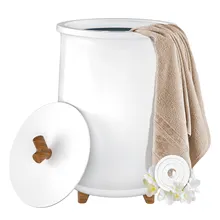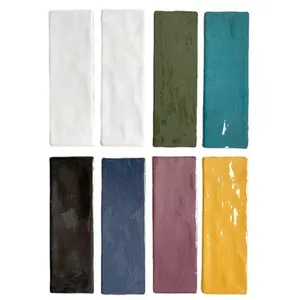The herringbone bathroom tile is a sophisticated and versatile product that brings a classic yet contemporary elegance to any bathroom space. This style of tile is characterized by its distinctive V-shape pattern, reminiscent of the bones of the herring fish, which can be laid in a variety of ways to create different effects. The herringbone pattern tile in bathroom settings is not just a design choice but also a statement of luxury and attention to detail.
Types and Characteristics of Herringbone Tiles
There is a diverse range of herringbone bathroom tile types, each with unique characteristics. From the classic white herringbone tile shower to the intricate small bathroom herringbone tile floor, the variety is vast. Some tiles are made of natural stone, offering a timeless appeal, while others are crafted from durable ceramic or luxurious glass, providing a modern twist to the traditional pattern. The herringbone subway tile shower brings a metropolitan chic to the mix, while the herringbone shower floor tile ensures a non-slip surface with added aesthetic value. Each type serves a different design purpose and can be chosen to complement the interior style of the bathroom.
Structure and Composition
The physical structure of herringbone bathroom tiling is meticulously designed. Each tile is cut to precise measurements to fit together in the characteristic zigzag pattern. The herringbone shower wall tiles, for instance, are often thinner to adhere easily to vertical surfaces without added weight. The interlocking nature of the pattern requires a careful balance of tile thickness, size, and weight to ensure a seamless installation with enduring stability.
Materials and Properties
The materials used in herringbone bathroom floor tile are chosen for their durability and aesthetic qualities. Natural marble offers veining patterns that are unique to each tile, crystal glass captures and reflects light, and metal options provide a modern, sleek look. These materials are not only chosen for their beauty but also for their longevity and ease of maintenance. For example, natural stone is renowned for its lasting durability, while glass tiles are resistant to mold and mildew, making them ideal for wet bathroom environments.
Applications and Business Usages
In the realm of business applications, herringbone bathroom wall tiles are a popular choice for luxury hotel bathrooms, high-end residential developments, and spa retreats. The pattern's ability to add depth and texture to spaces makes it a valuable design element for interior designers and architects. The use of herringbone bathroom tiles in commercial settings not only enhances the aesthetic appeal but also contributes to the property's value.
Functions and Tasks
The primary function of the herringbone pattern tile bathroom floor is to provide a waterproof and durable surface that can withstand the rigors of daily bathroom use. However, beyond this functional aspect, the herringbone pattern also plays a role in spatial design, guiding the flow of the space and creating visual interest. The bathroom with herringbone tile becomes a focal point, often influencing the placement of fixtures and fittings.
Features and Unique Selling Points
The distinct features of herringbone bathroom tiling include its ability to create an illusion of space in a small bathroom and to add a touch of luxury in larger ones. The herringbone shower tile is particularly notable for its slip-resistant qualities when chosen in the right material, making it a practical choice for safety-conscious consumers. Additionally, the ease of integrating with various design styles makes herringbone tiles a versatile option for many projects.
Benefits and Positive Outcomes
The benefits of installing herringbone bathroom floor tile extend beyond its visual appeal. It is a practical investment that adds value to a property. The ease of maintenance, especially with non-porous materials like glass and certain ceramics, means that the bathroom will look pristine for years to come. The herringbone pattern also hides water spots and smudges better than plain tiles, reducing the appearance of stains and making the bathroom easier to clean.
How to Use and Install Herringbone Tiles
Effective use of herringbone wall tiles bathroom involves strategic planning of the pattern layout to maximize the visual impact. Installation should start from the center of the area to ensure the pattern spreads evenly across the space. For those selecting the tiles, it is important to consider the size of the area and the scale of the herringbone pattern; smaller tiles for a small bathroom can make the space feel busier, whereas larger tiles can create a more open feel.
How to Choose and Maintain Herringbone Tiles
Choosing the right herringbone bathroom tile involves considering the overall design theme of the space, the level of foot traffic, and the maintenance requirements. For maintenance, regular cleaning with pH-neutral cleaners is recommended, and for natural stone tiles, resealing every few years is necessary to maintain their resistance to moisture and stains.
Target Audience and Meeting Needs
The target audience for herringbone bathroom tiles includes homeowners seeking to add a touch of elegance to their bathrooms, as well as commercial clients looking to create standout spaces in hotels or spas. These tiles meet the needs of a discerning clientele that values both aesthetics and functionality in their design choices.
How does the herringbone pattern enhance the bathroom space?
The herringbone pattern tile bathroom floor creates an illusion of space and adds a touch of sophistication. The interlocking patterns draw the eye, giving a sense of movement and flow that can transform the bathroom from a purely functional space to one of comfort and style.
What are the considerations for installing herringbone bathroom tiles?
Installation of herringbone shower wall tiles requires precision. The alignment of the pattern is crucial to achieving the desired effect. It is recommended to seek professional installation to ensure that the intricate patterns are perfectly executed, and the tiles are properly sealed and finished.
How to maintain the quality and appearance of herringbone tiles?
Maintenance of herringbone shower floor tile involves regular cleaning with non-abrasive products to prevent scratching the surface. For natural stone materials, periodic sealing may be necessary to prevent water damage and staining, ensuring that the herringbone pattern remains a timeless feature in the bathroom.










































 浙公网安备 33010002000092号
浙公网安备 33010002000092号 浙B2-20120091-4
浙B2-20120091-4